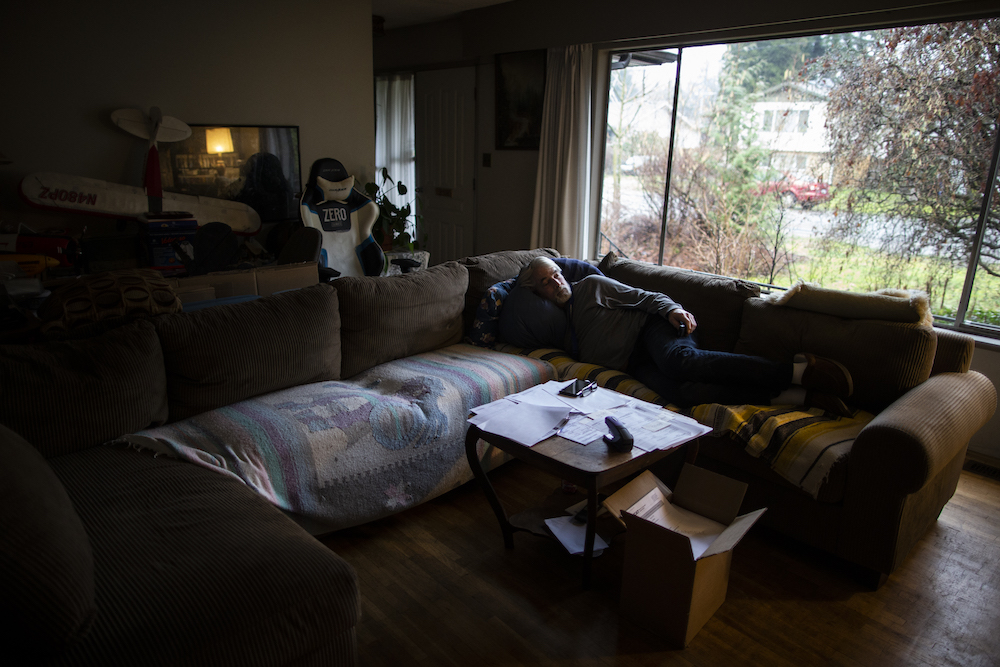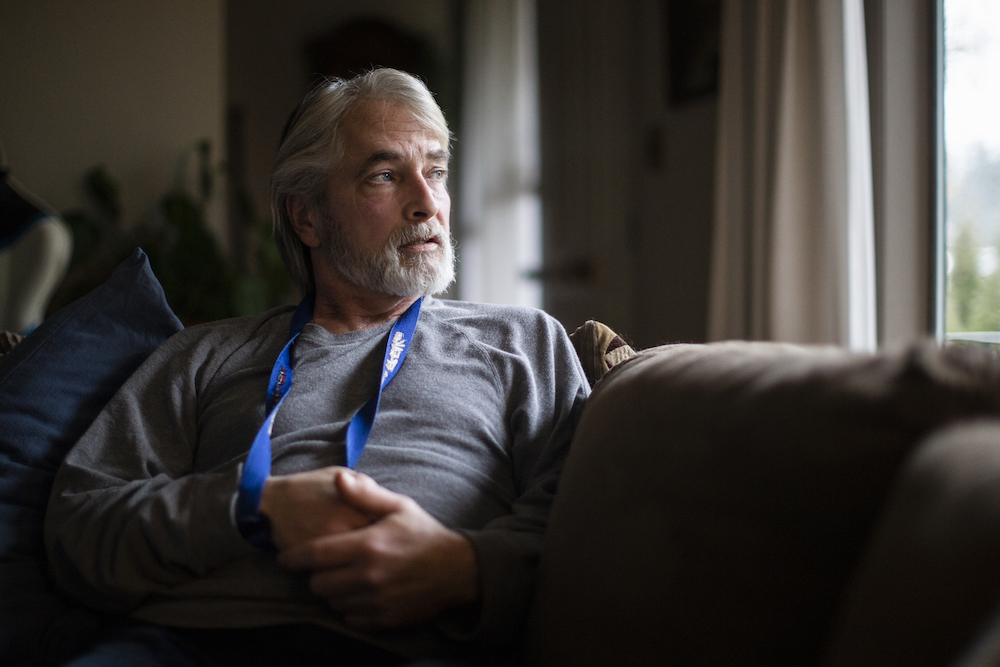It took seconds for a workplace injury to change James Mansell’s life.
He spent the next 12 years in a frustrating and ultimately unsuccessful effort to get help from WorkSafeBC.
Mansell, from Port Coquitlam, was 42 in 2008. He’d been a truck driver for some 15 years. It was the start of another workday, and he was attaching the thick lines that connect the truck to the trailer when something went wrong.
"It popped something in my shoulder when I was plugging the hydraulic lines in," he said.
He got medical attention, had surgery on the shoulder and was healing well. He hoped to be back at work soon.
Then a WorkSafeBC case worker sent him, without the knowledge of his doctors, to a physiotherapist who ended up re-damaging the shoulder, he said.
The goal seemed to be to rush him back to work, Mansell said. "My case worker took away my time needed to heal and went behind all my doctors’ and surgeons’ backs for a second opinion."
WorkSafeBC didn’t apologize.
"They basically did everything in their power as soon as they disabled me to hide the fact, in my opinion," Mansell said. "It wasn’t my work injury that disabled me, it was WorkSafeBC themselves that disabled me."
WorkSafeBC is mandated to promote safe and healthy workplaces, support rehabilitation of people injured at work and provide compensation to replace lost wages.
Funded with insurance premiums paid by employers and with investment income, under the system both employees and employers give up the right to sue in exchange for a predictable, no-fault method of determining how much support an injured worker is entitled to.
For privacy reasons, WorkSafeBC doesn’t comment on individual cases like Mansell’s.
"We know there is room for improvement, and we are always striving to meet the unique and individual needs of the injured workers of B.C.," a spokesperson said in an email. "Our goal is to provide exceptional service in all interactions with individual injured workers and employers to facilitate workers staying at work or returning to work, so that work-related injuries do not result in life-altering absences from the workplace."
WorkSafeBC measures its performance and reports out on it annually. In 2019, 82 per cent of workers rated their overall experience with the agency as "good" or "very good," the statement said.
But stories like Mansell’s are common, as injured workers complain the agency has refused to provide support or benefits and — one way or another — made life more difficult for someone already going through a hard time.
Major review completed, but not released
The NDP government has received three major reviews of the agency and is contemplating big changes to how it operates.
In April, it appointed a retired labour lawyer, Janet Patterson, to review the workers’ compensation system and make recommendations for changes to make the system more worker-centred. The government received her report in October but has yet to release it. It joins at least two previous reports on the system that the government has yet to act on.
B.C. Ombudsperson Jay Chalke’s submission to the review said his office gets hundreds of complaints a year about WCB.
Another worker, who asked for anonymity because they are still fighting for support, said their mental health claim from 2017 had generated a stack of documents some 40 centimetres thick, and they estimated their former employer had spent $100,000 fighting to have the claim denied. They said WorkSafeBC had found in their favour, but the employer had appealed the decision and succeeded in having it reversed.
"This is a totally rigged system," the worker in the B.C. Interior said.
Lacking WorkSafeBC support while the appeal is ongoing, they had found other work and made lifestyle changes in order to cope. But that had made it harder to recover, they said. "I’m still dealing with this injury while having to work."
Jaskarn Singh Gill of Cloverdale described an unsuccessful seven-year battle with WorkSafeBC after he injured his back while working as an aircraft painter. His story includes an injury to a spinal disc, surgery done at a private facility and two years in bed, all while battling WorkSafeBC for help.
Gill said WorkSafeBC policies are inconsistently applied and can be hard to find. Even the people responsible for applying the policies are at times unfamiliar with them, he said.
The father of two connects the problems with WorkSafeBC to the opioid crisis, depression and suicide, as the system leaves too many people desperate for help.


Mansell tells a complicated and detailed story that makes it clear he’s been interacting with an at-times mystifying bureaucracy. When there’s disagreement with WorkSafeBC — over treatment options or a worker’s ability to work—there’s little recourse.
A doctor paid by WorkSafeBC, who Mansell says he’s never met, has at times overruled the findings in medical reports written by the people who’ve actually treated him, he said. "How is that even possible? How is that even legal? But it happens."
Sometimes requirements from WorkSafeBC, like lifting weights to help with rehabilitation, contradicted the advice he was getting from the doctors caring for him. When there was a decision by the Workers’ Compensation Appeals Tribunal in his favour, WorkSafeBC ignored it, he said.
The end result has been a decade with no income. Through that time, Mansell and his wife raised two children, kids who were not yet teenagers when Mansell was injured. "We had to feed them with the food bank and eat every other day so they had food," he said.
The lack of support meant Mansell and his wife used up their savings, then in 2016 sold their house.
"Until we were forced to sell our home, we were living way below the poverty line with a zero income," he said. "We still have zero income; we’re just eating our assets. I don’t know what WorkSafe expects when they force people into this kind of a situation. What do they think is going to happen when their assets are all gone? What are they supposed to do then?"
Mansell said he had always worked hard until he was injured and isn’t a faker or fraudster. Yet when he needed help, it wasn’t available. "This is supposed to be Canada and it’s not. I don’t know what it’s turned into anymore."
A system ‘obsessed with rules’
Kevin Love, a lawyer with the Community Legal Assistance Society in Vancouver, has 14 years of experience with workers’ compensation cases. "We’re the people you call when you get to the end of the line and something needs to go off to court — the system has effectively failed the worker."
The society deals with several dozen cases involving WorkSafeBC each year. Love expressed sympathy for the challenges the agency faces, recognizing that it makes tough decisions.
But he said there’s also clearly a problem when so many people find the system so unwieldy that it can feel like a maze.
"What we see is the system seems to be obsessed with rules and procedures that no one can really understand, rather than actually trying to do what is fair and right for the worker," he said. "That is the main concern for us. It’s not just that a worker is in a tough spot in terms of getting benefits from the board, it’s that they can’t even understand what’s happened."
A spokesperson for WorkSafeBC said via email that the agency doesn’t let rules and procedures get in the way of helping B.C. workers when they are injured.
"Injured workers often have unique needs during their recovery and return to work," he said. "While there are rules and procedures that do guide decisions, WorkSafeBC is committed to supporting injured workers with their individual needs whenever possible under the Workers’ Compensation Act in order to overcome the effects and impacts of their injury."
Love said from the legal assistance society’s perspective, the law and how it’s interpreted are important.
But it’s also important that people feel they are treated with respect and dignity, he said, adding that after a couple of decades of declining supports and service at WorkSafeBC, too often that’s not the case.
"Overall, it seems we’ve come through a period that’s been marked by what I would say are unfounded concerns about the sustainability of the system," Love said. "There’s no doubt that the board has a difficult job to do. But there definitely seems to be a focus on minimizing cost to the system as opposed to delivering the benefits and support that a worker really needs."
Love said individuals and organizations put a lot of time and effort into making submissions to the Patterson review.
"Dozens of workers from across the province came out to share very difficult experiences because they were told it would help make the system better," he said. "If the Patterson report stays hidden away, it seems that their voices don’t really matter."
The Community Legal Assistance Society made a submission that included suggestions for improving the way mental and psychological claims are handled.
"So much work has been done to raise awareness about mental health in the workplace, yet the workers’ compensation system continues to throw up barriers to workers with mental or psychological injuries that simply don’t exist for workers with physical injuries," he said. "We say it’s time to tear down those barriers and provide fair compensation to workers with mental and psychological injuries."
High psychological cost for workers and families
Several people interviewed for this report mentioned Bhupinder Singh Kang, a worker who died by suicide in 2006. The coroner’s report on his death included 17 recommendations for WorkSafeBC.
WorkSafeBC introduced new programs, services and protocols to better support workers who are psychologically fragile or at risk of suicide after Kang’s tragic death, a spokesperson said in a statement.
"WorkSafeBC has supports which can be accessed on a timely basis for workers in crisis or workers in need of support while they wait for an eligibility decision on a mental disorder claim," he said.
"These supports include an immediate referral to a mental health specialist if there is any indication of suicidal thoughts; 24/7 access to a telephone crisis line and a team of social workers for crisis intervention support; supportive counselling; and specialized case managers to aid workers who have been identified as being at high risk of suicide."
There’s also a special care services department with a mandate to ensure that specialized services and supports are made available to workers with catastrophic physical injuries or significant psychological injuries, he said.
WorkSafeBC appointed a chief mental health officer in January 2019 "whose goal is to ensure mental injuries do not result in disability," a first for a compensation board in Canada, he said.
But Love said that at the Community Legal Assistance Society they see many cases where the workers’ compensation board misses opportunities to positively impact a worker’s mental health by providing needed supports and benefits.
"Often that interaction with the board is a negative experience that negatively impacts the worker’s mental health, which is really unfortunate," Love said. "With many of the people who call us looking for help, their mental health is a real concern and self-harm and suicide are very real concerns. That is concerning for us given that they are dealing with a system that is supposed to help injured workers, to be there for injured workers."
Gill has raised concerns about the agency with various MLAs, and he said it’s easy to get labelled, and dismissed, as someone who is simply disgruntled. "When you are trying to tell the truth and nobody is listening to you, it is such a frustrating thing," he said.
The government’s review of WorkSafeBC is promising, but there needs to be more than just talk, Gill said. "We’re hearing great things, but we’re not seeing anything."
Patterson submitted her report to Labour Minister Harry Bains in October, but there’s been no indication when the government will release the report or act on it.
Love hopes for speedy action.
"We’re very hopeful that the government will act soon to make changes to the system that are so badly needed," he said, "however we are concerned that there’s a report out there by an expert in workers’ compensation, who was hired to review the system and make recommendations, and… that hasn’t been released to be part of the process of making the system better."
Changes are needed and should be made based on Patterson’s review and recommendations, he said.
"The time is now to make this system better." ![]()
Read more: Rights + Justice, Labour + Industry
















Tyee Commenting Guidelines
Comments that violate guidelines risk being deleted, and violations may result in a temporary or permanent user ban. Maintain the spirit of good conversation to stay in the discussion.
*Please note The Tyee is not a forum for spreading misinformation about COVID-19, denying its existence or minimizing its risk to public health.
Do:
Do not: